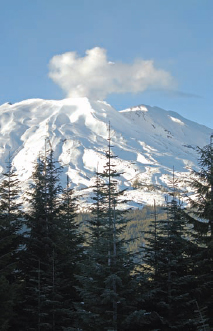Geography Oceanography, and WeatherVolcanoes |
What happened when Mt. St. Helens erupted? |
On the morning of May 18, 1980, a magnitude 5.1 earthquake struck beneath the Mt. St. Helens volcano in Washington state. Later that day, the volcano exploded, initiating a massive avalanche that tore away the northern slope of the mountain and created the largest landslide in recorded history. The conical volcano went from about 9,678 feet (2,950 meters) to 8,366 feet (2,550 meters) in height, releasing a giant plume of ash and gas high into the atmosphere. A lethal pyroclastic flow of hot steam, gas, and rock debris raced down the slope of the mountain, traveling as fast as 684 miles (1,100 kilometers) per hour.
A fine ash dust was propelled into the upper atmosphere (stratosphere) at heights reaching up to 15 miles (22 kilometers), spreading to the east by the prevailing westerly winds and eventually reaching all over the world. In a short time, the ash blanketed central Washington, the prevailing winds carrying an estimated 540 million tons of ash across 22,007 square miles (57,000 square kilometers) of the western United States. People in towns nearby (and some as far away as western Montana) were affected by the rain of ash. Car radiators were clogged, upper respiratory problems worsened, air and ground travel were disrupted, and a thick coating of ash particles covered everything outside. Despite such impressive statistics, the Mt. St. Helens eruption did not disrupt climate on a worldwide scale. There are two reasons for this: 1) the volcano did not release that much sulfur dioxide compared to some other major eruptions, and 2) the eruption blew out the side of the mountain, thus shooting debris at an angle and not as high into the atmosphere as might have otherwise happened.

